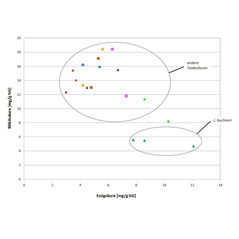Ensilage
As part of a research collaboration silages were prepared from different plant parts which were considered particularly suitable for the production of biogas due to a higher acetate and reduced lactat content.
The enhanced acetate production was induced by the inoculation of plant material with bacterial cultures from different physiological groups. In particular the addition of heterofermentative lactic acid bacteria significantly improved acetate formation in silage. The thus produced special experimental silages were added to a biogas production plant by the research partners. In this process the biogas production was qualitatively and quantitatively analyzed to determine differences.
The competitiveness of the test cultures used for the ensiling is very different and represents a significant challenge to the process. It was confirmed that the fermentation acid patterns and specific methane gain of plant samples were significantly influenced by the addition of biological silage additives. In this phase of the project, the principle of fermentation residue control was clearly confirmed. In additional research work a consortium of microorganisms suitable for biogas-oriented ensiling will be selected and assembled.

